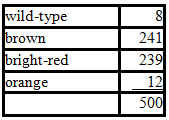During penetration of an Escherichia coli cell by the T4 bacteriophage,
a. the envelope fuses with the cell membrane, allowing the phage nucleocapsid to enter the cell.
b. integrase makes a pore in the cell wall, the tail sheath contracts, and the phage DNA is injected into the cell.
c. T4 lysozyme makes a pore in the cell wall, the tail sheath contracts, and the phage DNA is injected into the cell.
d. T4 lysozyme facilitates membrane fusion, allowing the phage to enter the cell.
Answer: C
You might also like to view...
Biological rhythms and the onset of sleep are regulated by ____ produced by the ____
a. cortisol; pineal gland b. melatonin; pituitary gland c. parathyroid hormone; parathyroid gland d. melatonin; pineal gland e. cortisol; adrenal gland
The mother of these progeny resulted from a cross between two flies from true-breeding lines. What are the genotypes of these two lines?
In Drosophila, the autosomal recessive pr and cn mutations cause brown and bright-red eyes, respectively (wild-type flies have brick-red eyes). Flies who are homozygous recessive at both pr and cn have orange eyes. A female who has wild-type eyes is crossed to an orange-eyed male. Their progeny have the following distribution of eye colors:

A) pr cn+ / pr cn+ and pr+cn / pr+cn
B) pr+cn+ / pr+cn+ and pr cn / pr cn
C) pr+cn+ / pr cn and pr cn / pr cn
D) pr+cn / pr cn and pr cn+ / pr cn
E) More than one of these could be true.
The mutated gene that causes cystic fibrosis is
a. CFTR b. CRFT c. CTFR d. CRTF e. CFRT
A red blood cell has lost its nucleus to make more space for carrying oxygen. This is an example of ________
A) the relationship between structure and function B) a cell whose DNA is circular C) a cell that is not living D) a prokaryotic cell